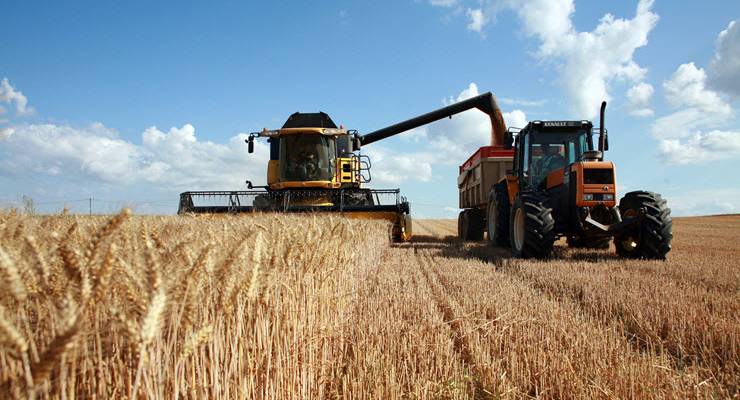
While the National Party holds the future of Australia’s climate policy hostage, it’s worth looking closer at exactly who it represents. The Nationals vote has been in decline for years now, from 11.5% of the first preference vote in 1987 under leader Ian Sinclair, to 4.5% in the most recent federal election under the leadership of Michael McCormack.
This shrinking vote share is neatly correlated with the rising urbanisation of Australia. Aussies live in cities now. So who do the Nats represent? They wear farmer hats, but there are fewer and fewer farmers in Australia.
As the next chart shows, the number of people employed in agriculture, fishing and forestry is down sharply from its highs in the early 1990s.
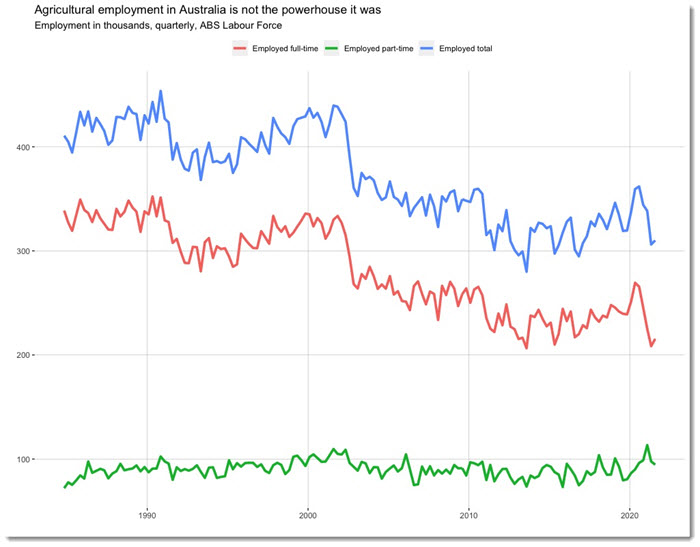
Look at how that green line is rising — that’s part-time work. Many casual and seasonal workers are bulking up the employment statistics, especially in fruit and vegetable farming, less so in cattle and sheep farming.
According to the 2016 census, the number of farmers in Australia is 141,419 (including farm managers). It simply isn’t that many. The agricultural labour force also includes around 50,000 overseas workers.
The states with the highest share of agricultural employment are the three big east coast states — NSW, Victoria and Queensland, where the National Party wins seats. The Nats have seven NSW seats, three Victorian seats, and are part of the Queensland Liberal National Party, which has 16 of the 18 seats outside urban Brisbane.
Victoria is notable as the state that has in recent years had the highest share of agricultural work, as the next graph shows. So do the Nationals do well there? Not especially. The Liberal Party has a stranglehold on a number of country seats and one of Australia’s few independents holds the rural seat of Indi.
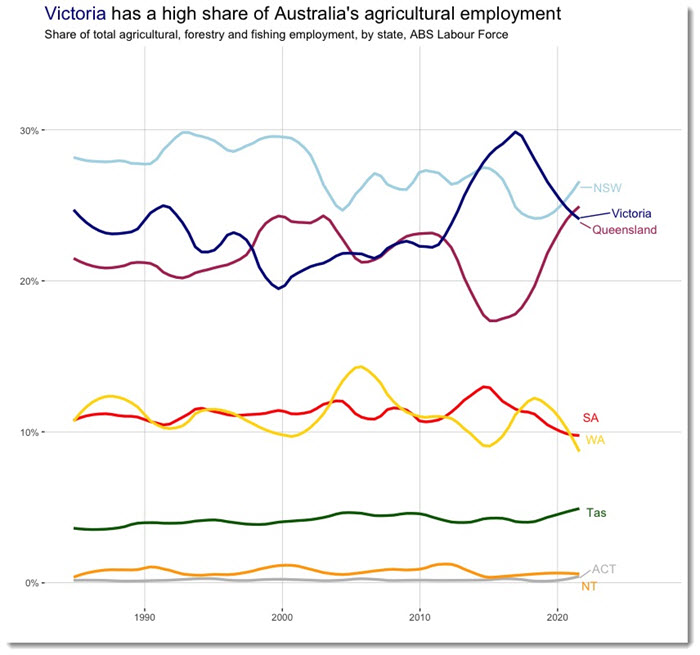
It’s not clear the Nationals represent farmers much any more. So who do they represent? Miners?
The farming industry is a bigger employer than mining, as the next chart shows. In Victoria, farms employ ten times as many people as mining. Most states have more farm workers than miners. (You can spot the blip in mining employment around 2012, during the mining boom.)
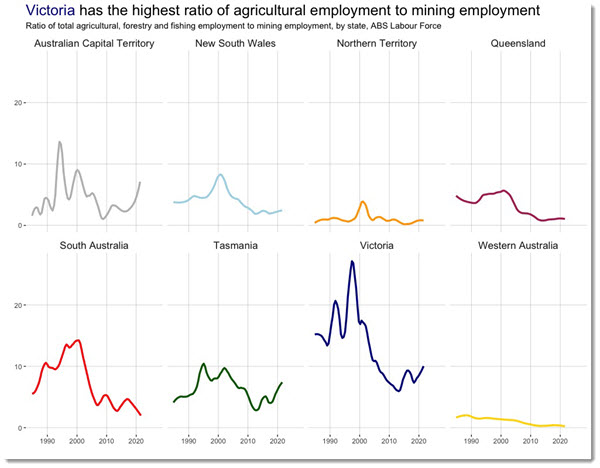
In Western Australia the reverse is true, with mining employing more than farming, but that doesn’t seem to be winning the Nationals any votes over there. The National Party holds no House of Representatives Seats for WA and has no senators in the state.
The National Party claims to stand for “building stronger regional economies” as “the only political party dedicated to advancing the interests of regional Australia”.
So what are the jobs in the regions?
The next graph uses a comparison to gives the answer: in the region around Barnaby Joyce’s seat of New England, employment is in healthcare, social assistance and farming. In the region around Anthony Albanese’s seat of Grayndler, employment is in professional services, retail, healthcare and construction.
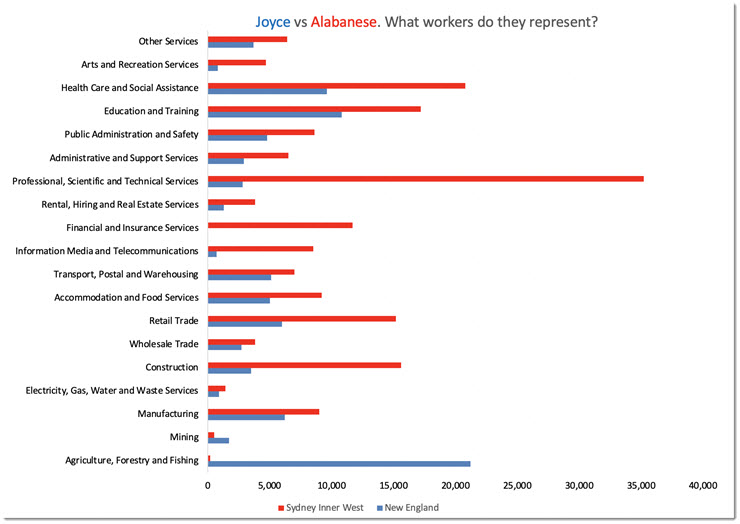
It is very hard for governments to stimulate job growth in the regions. I worked for a time at an organisation called Regional Development Victoria, and it is unclear if we achieved any development of the regions of Victoria whatsoever.
But what a government can’t do, a pandemic sometimes can.
Jobs in the regions are likely to grow if workers continue to flee the cities, liberated by remote working. Those changes will make the profile of country jobs look more like city jobs. And if that happens, the Nationals might find their electoral situation looking even more precarious.








With the notable exception of Bridget McKenzie the Victorian Nats have more in common with the old Country Party than with their supposed colleagues in the North. Their seats both state and federal have frequently proven to be susceptible to a challenge from credible independents – who have often won at subsequent polls. Indeed, were McKenzie not sheltered by red leather one might easily suppose she would be a prime candidate for such a challenge. Notably with Darren Chester, and even the unremarkable Damian Drum it is hard to see what they have in common with media constructs such as Joyce or C*n*v*n.
I suspect that a slogan in Victoria of “Vote Morrison – get Joyce“, especially in the seats where the ‘Voices of…” independents are running would have a deadly effect upon the ‘soft’ conservative vote.
Actually I am not so sure about independents winning Nat seats in Vic federally, (should have looked it up) but certainly at the state level
I’ll stick with the area i know generationally well..Gippsland/East Gippland ..approx. 100 yrs of CP/NP voting local/state/fed…(an abberation of an independent pops up rarely-Craig Ingram -state )..A major backbone of this regional economy is State funded public education & State funded hospital/health services. & Fed/state/local funded social services .the old mad cow cocky Country Party is history (thank hell ) & today’s majority of National Party voters are townie Coles & Woolies hunter n gatherers & consumers of as cheap as you can get mass produced commodities..Chester is a dead cert bet Fed wise to comfortably remain, & Tim Bull will plod along comfortably at the State level…Why change a 100 yrs of ‘entrenched traditions’ when the world has changed so much & changing even more rapidly !?..;-)
Sounds like traditional Nat voters will likely continue to vote Nat because it’s something they know, whereas anything else in this deeply scary world would be far too risky.
That Bridget McKenzie, she of the colours spreadsheet and sports torts?
Also once known as the Member for Elwood, when it emerged she was living in Melbourne and not the bush, which the Nationals claim to represent and who now owns another property in Middle Park, Melbourne
All the while supposedly being a National Party Senator for Victoria and claiming the she does in fact live in Wodonga?
https://www.smh.com.au/politics/federal/bridget-mckenzie-buys-2-million-house-as-second-melbourne-investment-property-20200123-p53twh.html
Internal migration within Victoria may change a lot of things. With an increasing move to the regions, the political ‘climate’ will change. Pun intended.
Yes, no cheaper housing rentals for working families any more. But housing sales/renovations for sell off later are increasing. They who have financial credit are doing extremely well.
The name ‘National’ seems blatantly false advertising, in my opinion. The money grubbing rorts and stupidity on climate change is nauseating and embarrassing.
Interesting, maybe regional townships and cities have become more important for the Nats vs. actual farmers while many regional people have no issue with refugees, immigrants and population growth to spur things along, but you need to get them in when young for a hope they will stay (vs. urban agitprop on ‘immigrant hell’).
Many regional centres are not that attractive for urban types except retirees, white collar/freelance who can work remotely and those with clear skills in demand e.g. health/medical, trades, accounting etc.. It can be very difficult for working age urban Australians (without school age children) to migrate then break into regional professional networks (local pecking orders) for employment, amongst other barriers to outsiders including local culture.
Like elsewhere, many regional areas are in decline and looking more like Central European/Russian regions suffering ageing, emigration, population then economic decline, loss of services and political neglect.
One also suspects that Sky News being broadcast free to air into regions i.e. townships, pubs, clubs, aged care etc. is to access and influence voters, especially older, to match electoral strategies in the US and UK that have been successful in garnering the above median age vote.
Ah, the Sky After Dark Comedy Show, the Moloch’s Australian version of FauxNews which really does appears to be like some strange US sitcom.
Set in a TV station where the inmates appear to be mendacious, paranoid, scared of the other, black/brown/yellow/aliens of any sort, people who have the temerity to present facts and question them and are all very shouty at such and that even at their own cohort.
The inmates consist of right wing to libertarian current and ex politicians, their enablers, media hacks of no particular worth as well as the odd RWRNJ, the second R being for Religious
Out here in regional Australia Sky has been inflicted on FTA , in a desperate attempt to increase its dismal ratings, so no need to subscribe to the stupidity it pops up while going through to other channels.
Those inmates on the Sky After Dark Comedy Show, carrying on in the same deluded maniacal fashion about the fraud in the 2020 US Election.*
* a question that they refused to acknowledge is…
If the Democratic Party ran such a fraudulent election, how come it both lost seats in the House and only gained a majority in the Senate following the Georgia runoff?
I read that West Virginia was offering financial incentives for professionals that can work remotely to move to the country, bringing a much-needed influx of people into regional areas. You’d think with good telecommunications and infrastructure, the barriers for those who live in the city for the “agile economy” but would want to live regionally would be taken away.
Yay for our NBN…?
Think about what might have been had Trumble not made it “cheaper, quicker, sooner“!
What’s the old tradie saying, “If you haven’t time to do it properly, you’ll need time to do it again.”
Can’t have good NBN in the bush because outback teens will use all the bandwidth playing video games…
The real reason is the The Moloch was concerned about losing numbers to his subscription channels.